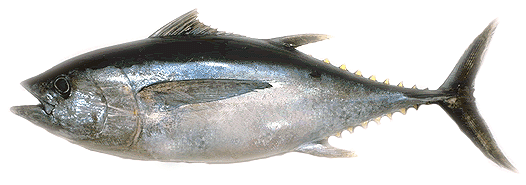|
|
|
||||||
 Tuna, Bigeye (Thunnus obesus) Mebachi
(Japan), Patudo (Spain) Tuna, Bigeye (Thunnus obesus) Mebachi
(Japan), Patudo (Spain)One of the larger tuna it is found in tropical to temperate waters in the Pacific, Atlantic, and Indian Oceans. In the U.S. most of the production comes from the East Coast from North Carolina up through New York. Major Big Eye fisheries are the Azore Islands, Chile and Peru where 200 pound catches are common. The Bigeye are known in Hawaii as ahi as are the yellowfin and this species is prized for its pronounced rich flavor, with high oil content and meaty texture. With is fat marbling near the skin, a sign of good flavor, the Japanese rate the Bigeye second only to the Bluefin for sashimi. The Bigeye has a similar appearance to the yellowfin but with a larger head and eye and have been caught up to 500 pounds but they average 20 to 100 pounds.. The meat when compared to the yellowfin is darker and oilier. These tuna swim at greater depths than most other tuna and are less abundant than the yellowfin, skipjack, or albacore.
Bigeye retain their color longer than other tuna like the yellowfin and therefore are considered to have a longer shelf life. The flesh is not as light as Albacore but not as dark as the Bluefin Tuna. Temperature control is of great importance from the time the tuna is landed as scombroid poisoning from a histamine produces as a result of tuna that sits in the sun too long after being landed. |
|||||||
|
|
|||||||
